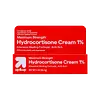What's inside
What's inside
 Key Ingredients
Key Ingredients

 Benefits
Benefits

 Concerns
Concerns

 Ingredients Side-by-side
Ingredients Side-by-side

Hydrocortisone 1%
Aloe Barbadensis Sprout
HumectantCetearyl Alcohol
EmollientChamomilla Recutita Oil
MaskingCitric Acid
BufferingZea Mays Oil
EmulsifyingGlycerin
HumectantGlyceryl Stearate
EmollientIsopropyl Palmitate
EmollientMaltodextrin
AbsorbentMethylparaben
PreservativeParaffinum Liquidum
EmollientParaffin
PerfumingPetrolatum
EmollientPropylene Glycol
HumectantPropylparaben
PreservativeWater
Skin ConditioningStearyl Alcohol
EmollientRetinol
Skin ConditioningCholecalciferol
Tocopherol
AntioxidantHydrocortisone 1%, Aloe Barbadensis Sprout, Cetearyl Alcohol, Chamomilla Recutita Oil, Citric Acid, Zea Mays Oil, Glycerin, Glyceryl Stearate, Isopropyl Palmitate, Maltodextrin, Methylparaben, Paraffinum Liquidum, Paraffin, Petrolatum, Propylene Glycol, Propylparaben, Water, Stearyl Alcohol, Retinol, Cholecalciferol, Tocopherol
 Reviews
Reviews

Ingredients Explained
These ingredients are found in both products.
Ingredients higher up in an ingredient list are typically present in a larger amount.
Petrolatum is more commonly known as petroleum jelly. It is created by mixing waxes and mineral oils.
This ingredient is effective at reducing water loss by 99%. This is because it is an occlusive. Occlusives create a hydrophobic barrier on the skin to prevent evaporation. This property makes it great for hydrating dry skin.
Pro tip: Use occlusives, such as this ingredient, on damp skin for the best results.
The quality or origin of petrolatum is only known when disclosed by the brand. Most cosmetic petrolatum has gone through several purification stages.
Another benefit of occlusives is it protects your skin against infection or allergies.
Petrolatum may not be safe for fungal-acne. Studies show mineral oil / petroleum leads to the growth of M. Furfur, a type of yeast.
Learn more about Petrolatum